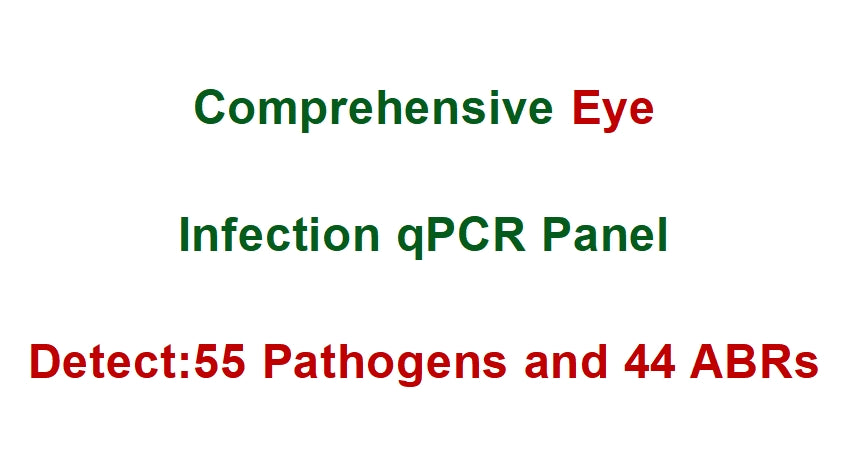Comprehensive Eye Infection qPCR Panel
Comprehensive Eye Infection qPCR Panel
无法加载取货服务可用情况
Comprehensive Eye Infection qPCR Panel
This advanced molecular diagnostic panel utilizes quantitative PCR (qPCR) technology to detect 55 ocular pathogens—including 32 viruses, 19 bacteria, and 4 fungi—alongside 44 key antibiotic resistance (ABR) genes. It is one of the most extensive panels available for eye infection diagnostics.
By analyzing specimens such as tears, conjunctival swabs, or ocular fluids, this panel provides rapid and highly accurate results, enabling early diagnosis and timely clinical intervention.
Specimen Types:
Tears, conjunctival swabs, corneal scrapings, aqueous humor, and vitreous fluid.
Eye Infections: Overview
Eye infections, also known as ophthalmic infections, may be caused by bacterial, viral, or fungal pathogens and can affect various parts of the eye. Depending on their origin and location, infections can range from mild irritation to vision-threatening conditions. Prompt diagnosis and treatment are essential to prevent serious complications.
Common Types of Eye Infections
· Conjunctivitis (Pink Eye): Inflammation of the conjunctiva. Commonly viral or bacterial.
· Keratitis: Infection or inflammation of the cornea, often linked to trauma or contact lens misuse.
· Endophthalmitis: A severe infection inside the eyeball that requires urgent treatment.
· Blepharitis: Chronic eyelid inflammation, usually associated with bacterial overgrowth.
· Stye (Hordeolum): A painful eyelid bump caused by infection of an eyelash follicle or oil gland.
· Uveitis: Inflammation of the eye's middle layer, possibly due to infection or autoimmune disease.
· Periorbital/Orbital Cellulitis: Serious bacterial infections surrounding the eye that can spread rapidly.
Symptoms of Eye Infections
· Redness in or around the eye
· Eye pain or gritty sensation
· Swollen eyelids or conjunctiva
· Watery, mucous, or purulent discharge
· Sensitivity to light (photophobia)
· Blurred or reduced vision
Causes of Eye Infections
· Microorganisms: Includes bacteria (e.g., Staphylococcus, Streptococcus), viruses (e.g., adenovirus, herpes simplex), and fungi (e.g., Candida, Fusarium).
· Contact Lens Use: Improper hygiene or extended wear increases infection risk.
· Eye Injury or Surgery: Breaks in the ocular barrier can allow pathogen entry.
· Compromised Immunity: Chronic diseases or immunosuppression raise susceptibility.
Benefits of the qPCR Panel
· Speed: 5-24 hour result, qPCR significantly reduces turnaround time compared to traditional cultures.
· Sensitivity: Detects even low levels of pathogen DNA with high accuracy.
· Multiplexing: Simultaneously identifies multiple pathogens in a single test.
· Specificity: Targets specific DNA sequences to ensure accurate detection and differentiation.
Viruses (32)
· Adenovirus AdV_1of2
· Adenovirus AdV_2of2
· COVID-19 (N gene + S gene)
· Human Bocavirus
· Human Coronavirus 229E
· Human Coronavirus HKU1
· Human Coronavirus NL63
· Human Coronavirus OC43
· Human Enterovirus (pan assay)
· Human Enterovirus D68
· Human herpesvirus 3 (Varicella zoster Virus)
· Human herpesvirus 4 (Epstein-Barr Virus)
· Human herpesvirus 5 (Cytomegalovirus)
· Human herpesvirus 6
· Human Metapneumovirus (hMPV)
· Human Parainfluenza virus 1
· Human Parainfluenza virus 2
· Human Parainfluenza virus 3
· Human Parainfluenza virus 4
· Human parechovirus
· Respiratory Syncytial Virus A (RSVA)
· Respiratory Syncytial Virus B (RSVB)
· Human Rhinovirus 1/2
· Human Rhinovirus 2/2
· Influenza A panel
· Influenza A/H1-2009
· Influenza A/H3
· Influenza B
· Measles virus (Measles morbillivirus)
· MERS
· Mumps virus (Mumps rubulavirus)
· SARS
Bacteria (19)
· Bordetella holmesii
· Bordetella pan assay
· Bordetella pertussis
· Clamydia trachomatis
· Chlamydophila pneumoniae
· Coxiella burnetii
· Haemophilus influenzae
· Klebsiella pneumoniae
· Legionella pneumophila
· Moraxella catarrhalis
· Mycobacterium avium
· Mycobacterium kansasii
· Mycobacterium tuberculosis
· Mycoplasma pneumoniae
· Pseudomonas aeruginosa
· Staphylococcus aureus
· Streptococcus agalactiae
· Streptococcus pneumoniae
· Streptococcus pyogenes
Fungi (4)
· Aspergillus niger
· Candida albicans
· Candida auris
· Pneumocystis jirovecii
44 Antibiotic Resistance Genes (ABRs)
blaACC: Acinetobacter-derived cephalosporinase
blaACT: AmpC-type cephalosporinase
blaCMY: Citrobacter freundii-derived AmpC-type beta-lactamase
blaLAT: Latent AmpC-type beta-lactamase
blaFOX: Cephamycin-hydrolyzing AmpC beta-lactamase
blaGES: Guiana extended-spectrum beta-lactamase
blaMIR: Morganella morganii-inducible cephalosporinase
blaVIM: Verona integron-encoded metallo-beta-lactamase
Cfr: Chloramphenicol-florfenicol resistance methyltransferase
CMY/MOX/DHA: AmpC-type beta-lactamases (CMY, MOX, DHA families)
CTX-M_1: Cefotaximase-Munich beta-lactamase group 1
CTX-M_2: Cefotaximase-Munich beta-lactamase group 2
CTX-M_8_25: Cefotaximase-Munich beta-lactamase groups 8 and 25
CTX-M_9: Cefotaximase-Munich beta-lactamase group 9
dfrA1: Trimethoprim-resistant dihydrofolate reductase type A1
dfrA5: Trimethoprim-resistant dihydrofolate reductase type A5
ermA: Erythromycin ribosome methylation A gene
ErmB: Erythromycin ribosome methylation B gene
ErmC: Erythromycin ribosome methylation C gene
IMP-1: Imipenemase metallo-beta-lactamase type 1
IMP-2: Imipenemase metallo-beta-lactamase type 2
KPC: Klebsiella pneumoniae carbapenemase
MCR-1: Mobile colistin resistance gene 1
MecA: Methicillin resistance gene A
MecC: Methicillin resistance gene C
mefA: Macrolide efflux gene A
NDM: New Delhi metallo-beta-lactamase
OXA-48: Oxacillinase-48 carbapenemase
OXA-51: Oxacillinase-51 carbapenemase (Acinetobacter)
PER-1: Pseudomonas extended resistance beta-lactamase
qnrA: Quinolone resistance protein A
QnrB_1of4: Quinolone resistance protein B (variant 1 of 4)
QnrB_2of4: Quinolone resistance protein B (variant 2 of 4)
QnrB_3of4: Quinolone resistance protein B (variant 3 of 4)
QnrB_4of4: Quinolone resistance protein B (variant 4 of 4)
qnrS: Quinolone resistance protein S
SHV: Sulfhydryl variable beta-lactamase
Sul1: Sulfonamide resistance gene 1
Sul2: Sulfonamide resistance gene 2
Tet(M): Tetracycline resistance protein M
Tet(S): Tetracycline resistance protein S
vanA2: Vancomycin resistance gene cluster A2
vanB: Vancomycin resistance gene cluster B
VEB: Vietnamese extended-spectrum beta-lactamase
分享
files/EYE.jpg
06:34 PM


